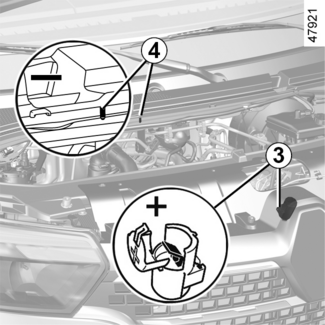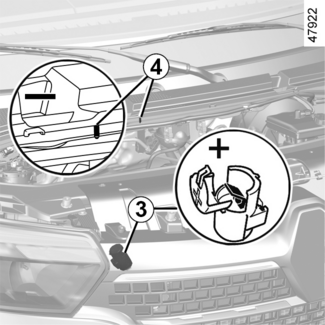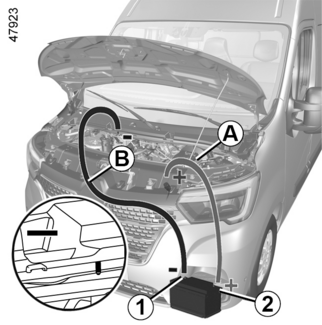Battery: breakdown recovery
Battery: breakdown recovery
WARNING
Special procedures may be required to charge some batteries. Contact your approved
dealer.
Avoid all risk of sparks which may cause an immediate explosion, and charge the battery
in a well ventilated area.
Risk of serious injury.
WARNING
Before carrying out any action in the engine compartment, you must switch off the
ignition STARTING, STOPPING THE ENGINE.
Risk of injury.
WARNING
Handle the battery with care as it contains sulphuric acid which must not come into
contact with the eyes or skin. If it does, wash the affected area with plenty of cold
water. If necessary, consult a doctor.
Keep any flames, red hot objects or sparks away from the battery components (risk
of explosion).
Please note when working close to the engine that it may be hot. The engine cooling
fan may also start at any moment. The  label in the engine compartment reminds you of this.
label in the engine compartment reminds you of this.
Risk of injury.
To avoid all risk of sparks:
- Ensure that the "energy consumers" (ceiling lights, etc.) are switched off before disconnecting or reconnecting a battery;
- when charging, switch off the charger before connecting or disconnecting the battery;
- do not place any metal objects on the battery as this may create a short circuit across the terminals;
- always wait at least one minute after the engine has been switched off before disconnecting a battery;
- make sure that you reconnect the battery terminals after refitting.
Connecting a battery charger
The battery charger must be compatible with a battery with nominal voltage of 12 volts.
Do not disconnect the battery while the engine is running. Follow the instructions given by the manufacturer of the battery charger you are using.
When many accessories are fitted to the vehicle, have them connected to the + After ignition feed.
Starting the vehicle using the battery from another vehicle
WARNING
Ensure that there is no contact between cables A and B and that positive cable A is not in contact with any metallic component in the vehicle supplying the current.
Risk of injury and/or damage to the vehicle.
If you have to use the battery from another vehicle to start, obtain suitable jump
leads (with a large cross section) from an approved dealer or, if you already have
jump leads, ensure that they are in perfect condition.
The two batteries must have an identical nominal voltage: 12 V. The battery supplying the current should have a capacity (amp-hours, Ah) which is
at least the same as that of the discharged battery.
Ensure that there is no risk of contact between the two vehicles (risk of short circuiting
when the positive terminals are connected). Switch off your vehicle ignition.

Attach the positive cable (+) A to terminal 3, then to terminal (+) 2 of the battery supplying the current.
Attach the negative cable (–) B to terminal (–) 1 of the battery supplying the current, then to earth (–) 4.


Start the engine of the vehicle supplying the current and run it at an intermediate
engine speed.
If your vehicle's engine does not start immediately, switch off the ignition and wait
a few seconds before repeating the operation.
With the engine running, disconnect cables A and B in the reverse order (4 - 1 - 2 - 3).